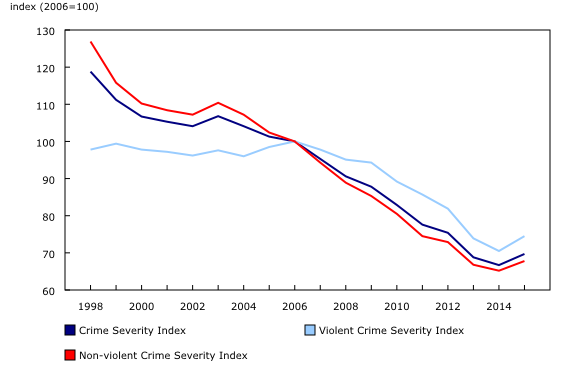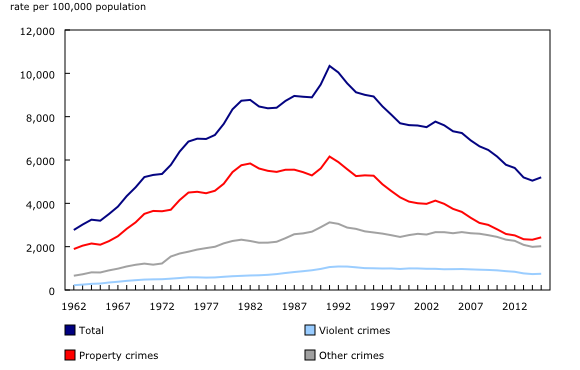Police-reported crime statistics, 2015
Archived Content
Information identified as archived is provided for reference, research or recordkeeping purposes. It is not subject to the Government of Canada Web Standards and has not been altered or updated since it was archived. Please "contact us" to request a format other than those available.
Released: 2016-07-20
Police-reported crime in Canada, as measured by both the Crime Severity Index (CSI) and the crime rate, increased in 2015. This marked the first rise in police-reported crime in 12 years. The CSI grew 5% from 2014 to 2015, but was 31% lower than it was a decade earlier in 2005.
The rise in the CSI, which measures the volume and severity of police-reported crime, was primarily a result of more incidents of fraud, breaking and entering, robbery, and homicide. A notable increase in crime reported in Alberta and smaller increases in British Columbia, Ontario and Saskatchewan also contributed to the upward movement of the national CSI.
The traditional police-reported crime rate, which measures the volume of police-reported crime relative to the population size, also increased in 2015, rising 3% from the previous year. While the crime rate grew in 2015, it has generally been on a downward trend since the early 1990s, with the only other increase reported in 2003.
There were almost 1.9 million Criminal Code incidents (excluding traffic) reported by police in 2015, approximately 70,000 more than in 2014.
In 2015, rates of police-reported crime increased for most Criminal Code violations. Among the violent violations with an increase in rate were attempted murder (+22%), Criminal Code violations specific to the use, discharge and pointing of firearms (+22%), homicide (+15%), robbery (+5%), sexual assaults (+4%), and major assaults (+3%).
Rates for all types of property crimes increased from 2014 to 2015, including fraud (+15%), possession of stolen property (+13%), identify fraud (+9%), theft over $5,000 (excluding motor vehicles) (+8%), theft of a motor vehicle (+6%) and breaking and entering (+4%).
The overall volume and severity of violent crime, as measured by the violent CSI, increased 6% from 2014 to 2015, largely due to increases in robbery, homicide, attempted murder, and violations specific to the use, discharge and pointing of firearms. Increases in violent crime in Alberta, British Columbia and Ontario also contributed to the increase in the national violent CSI.
The non-violent CSI grew 4% in 2015, driven by a rise in police-reported incidents of fraud and breaking and entering. Several provinces, most notably Alberta, reported an increase in property crime, contributing to the gain in the national non-violent CSI.
Police-reported crime up in most provinces and territories
In 2015, the police-reported CSI rose in 8 of the 13 provinces and territories. The largest increases were reported in Alberta (+18%), New Brunswick (+12%), the Northwest Territories (+10%) and Saskatchewan (+10%). Since the inception of the CSI in 1998, there have only been three other occasions when a provincial increase of 10% or more was seen.
In Alberta, the higher CSI was primarily the result of more incidents of breaking and entering, theft of $5,000 or under, and motor vehicle theft. Higher numbers of incidents of breaking and entering in 2015 also contributed to the increase in CSI in New Brunswick, Manitoba, Saskatchewan and the Northwest Territories, but other violations contributed as well.
The CSI for Ontario, Canada's largest province, increased 2%, largely due to a growth in police-reported fraud.
Prince Edward Island (-10%), Nova Scotia (-7%), Nunavut (-4%), Quebec (-3%) and Yukon (-2%) reported lower CSIs in 2015.
A decrease in the number of homicides contributed to the decline in the CSI for Prince Edward Island, Yukon and Nunavut. Fewer incidents of breaking and entering and thefts of $5,000 or under were responsible for the lower CSI for Nova Scotia.
Similar to previous years, CSIs and crime rates were highest in the territories, followed by the western provinces. In all three territories, a large part of the difference between the territorial and national CSI can be attributed to a high volume of less serious crime, such as mischief, which accounted for 37% of police-reported crime in the territories, compared with 15% nationally.
The western provinces all reported CSIs and crime rates in 2015 that were higher than the national average, with Saskatchewan continuing to record both the highest CSI (135.8) and crime rate (11,178 incidents per 100,000 population) among the provinces.
The high CSIs reported in the western provinces can be partly attributed to the relatively high number of incidents of breaking and entering. As in the territories, mischief was also an important contributing factor to high CSIs, accounting for 23% of police-reported crime in Saskatchewan and 24% in Manitoba.
Prince Edward Island (49.7), Ontario (50.6) and Quebec (55.7) reported the lowest CSIs in 2015.
Crime Severity Index increases in most census metropolitan areas
Of the 33 census metropolitan areas (CMAs) in Canada, 20 reported increases in their CSI values in 2015. Calgary (+29%) reported the largest increase, followed by Moncton (+20%), Victoria (+16%), Edmonton (+16%) and Abbotsford–Mission (+14%). The CMAs with the largest declines in CSI were Thunder Bay (-11%), Québec (-6%) and Sherbrooke (-6%).
As has been the case since 2010, the two CMAs with the highest CSIs in 2015 were Saskatoon (112.5) and Regina (107.6). Relatively high CSIs were recorded in Edmonton (101.6), Kelowna (98.0), Abbotsford–Mission (96.6) and Vancouver (96.2).
The CMAs with the lowest CSIs continued to be Québec (41.8), Barrie (43.3), Toronto (45.7), Ottawa (46.5), Guelph (48.4) and Sherbrooke (49.2).
Rate of cannabis and cocaine-related drug offences has fallen in recent years, while other drug crime has grown steadily
In Canada, drug offences such as possession, trafficking, importation and exportation, and production fall under the Controlled Drugs and Substances Act (CDSA). In 2015, there were about 96,000 CDSA offences reported by police, representing a rate of 269 per 100,000 population. Of these offences, half (51%) were incidents of cannabis possession, while 9% were related to the trafficking, production or distribution of cannabis.
In contrast to the increase in most crimes in 2015, the overall rate of police-reported drug violations decreased 9% in 2015. This decrease was primarily the result of a lower rate of drug offences involving cannabis (-15%); the rate of cannabis offences has been falling steadily since 2011. In 2015, the rate of police-reported offences related to cocaine (-7%) declined for the third year in a row.
CDSA offences related to drugs other than cannabis or cocaine accounted for 23% of all drug crime in 2015. Unlike offences related to cannabis or cocaine, rates for these other drug offences increased in 2015 (+14%) and have generally been increasing since 1995. Police reported a notable increase in the possession and trafficking, production and distribution of methamphetamines or crystal meth (+25%) in 2015. Rates also increased for drug offences related to heroin (+18%), methylenedioxyamphetamine or ecstasy (+7%) and "other drugs" such as LSD, "date rape" drugs and prescription drugs such as fentanyl (+6%).
Fewer youth accused of crime in 2015
There were approximately 92,000 youth accused of a Criminal Code offence in 2015, about 2,700 fewer than in the previous year. Youth include persons aged 12 to 17 years.
Of the 92,000 youth accused of a criminal offence in 2015, 45% were formally charged or recommended for charges by police, while 55% were dealt with by other means, including those diverted from the formal criminal justice system through the use of warnings, cautions, referrals to community programs and other diversion programs.
From 2014 to 2015, the Youth Crime Severity Index (YCSI) declined for the ninth consecutive year, down 1% to 60.6. The decrease in the YCSI was primarily due to reductions in non-violent crime. The YCSI measures both the volume and severity of police-reported crime by youth (both charged and not charged).
In 2015, there were 1,888 youth accused of property crimes by police for every 100,000 youth in Canada. This represented a 1% decline in the rate of youth accused of property crime, and includes a 2% decrease in mischief. The rate of youth accused of theft of $5,000 and under was not significantly changed. These are the two most common property crimes for which youth are accused.
At 1,265 per 100,000, the rate of youth accused of violent crime was 1% lower in 2015. The rate decreased 2% for common assault and 8% for uttering threats, the two most common police-reported violent crimes committed by youth. However, the rate of youth accused of sexual assault (+4%) and major physical assault (+2%) increased.
With the increase in homicides in 2015, there were 35 youth charged with homicide, 6 more than in 2014.
While the overall rate of youth charged was down 1% and the rate of youth dealt with otherwise by police declined 2%, the rate of adults charged was up 2% in 2015.
Note to readers
The crime rate and the Crime Severity Index (CSI) are complementary measures of police-reported crime. The crime rate measures the volume of crime reported to the police per 100,000 population, while the CSI measures both the volume and severity of crimes reported to the police.
To calculate the CSI, each violation is assigned a weight. CSI weights are based on the violation's incarceration rate and the average length of prison sentence handed down by criminal courts. The more serious the average sentence, the higher the weight for that offence. To calculate the CSI, the weighted offences are summed and then divided by the population. As with the other indexes, to simplify comparison, the CSI is then standardized to a base year of "100" (for the CSI, the base year is 2006). In other words, all CSI values are relative to the Canada-level CSI for 2006. CSI values are available back to 1998.
In addition to the overall CSI, a Violent Crime Severity Index and a Non-violent Crime Severity Index were created. Like the overall CSI, they have been standardized; therefore, the values for these indexes are relative to the Canada-level indexes for the base year, namely "100" for 2006.
For more information on the concepts and use of the severity indexes, see the document, Measuring Crime in Canada: Introducing the Crime Severity Index and Improvements to the Uniform Crime Reporting.
Data are drawn from the Uniform Crime Reporting Survey, a census of all crime known to and substantiated by police services. However, for incidents of child pornography, due to the complexity of these incidents, the data likely reflect the number of active or closed investigations for the year that reside within the police records management system, rather than the total number of incidents reported to police. Police-reported crime statistics conform to a nationally approved set of common crime categories and definitions. They have been systematically reported by police services and submitted to Statistics Canada every year since 1962. Differences in local police service policies, procedures and enforcement practices can affect the comparability of crime statistics at the municipal level.
Statistics Canada also collects self-reported victimization data from the General Social Survey on Victimization (GSS).The GSS collects information on self-reported incidents of criminal victimization, regardless of whether they were reported to the police. The GSS on Victimization is carried out every five years; the most recent cycle for which data are available was conducted in 2014.
Products
The Juristat article, "Police-reported crime statistics in Canada, 2015" (85-002-X), is now available. From the Browse by key resource module of our website under Publications, choose All subjects, then Crime and justice, and Juristat.
For more information on the Crime Severity Index, see the video, "Measuring crime in Canada: a detailed look at the Crime Severity Index."
Additional data are available upon request.
Contact information
For more information, or to enquire about the concepts, methods or data quality of this release, contact us (toll-free 1-800-263-1136; 514-283-8300; STATCAN.infostats-infostats.STATCAN@canada.ca) or Media Relations (613-951-4636; STATCAN.mediahotline-ligneinfomedias.STATCAN@canada.ca).
- Date modified:





